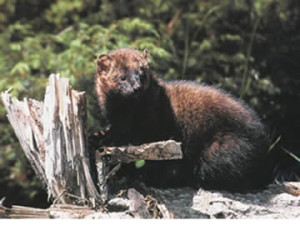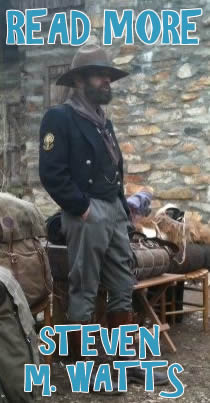This morning we were very fortunate. The conditions were ideal for tracking. Early last night, an inch of dry, light snow sifted down through the trees and covered the forest floor. Underneath this fine layer, nothing of the previous winter snows remained except for a hard-packed crust. This allows one to move through the woods and dense brush without being encumbered by snowshoes. And, since there has been a warming trend the past few weeks, all the animals moved around last night. There were zillions of tracks everywhere!
I awoke immediately at sunrise, bolted down a hurried breakfast, pulled on my boots and rushed out the door. Yeah!!! First I walked over to the fleshing poles where I’ve been tanning my deer hides. The meat and fur scattered around this area has been attracting all sorts of animals, particularly the crows.
Yesterday while reading a book I watched them fly by the window all day with tufts of fur in their mouths, trip after trip after trip, constantly. They must be building the most luxurious nest ever! I had gone out several times in the day to check out their tracks. The crow who happened to be gathering fur would fly fifteen feet up into a tree above the pile and caw at me when I approached, probably very annoyed about being interrupted. But then I noticed this cawing was just part of a larger chain reaction, crows further off in the distance repeating the call of annoyance, until I heard the cawing all the way down at the far end of the lake. Kind of like an advanced warning system. Then I noticed another crow in the top of a white pine overlooking the whole scene, that was eyeballing the entire field, including the crow on the ground. He was always the first to spot me, because the ground crow was busy picking through his treasure. This “sniper crow” would give me away, issuing a call that instantly sent the ground crow up into the tree, to safety. After all, what if I had been a Coyote? It would have been two birds with one stone for Coyote. Or more accurately one bird and one pile of deer flesh. The crows had a clever system.
The Coyotes came into the field last night. Rarely do they cross over the road, but they must have been tempted by the mound of flesh. It is still early in the season, and many animals are hungry. There were many smaller Coyote tracks as well. So many tracks leading off in all directions that I wanted to follow… but I had an appointment with a Fisher.
I met the Fisher on my very first morning out here at Rust Pond. I was crashing through the woods, behaving unknowingly like a predator, when I heard a squealing sound. If you put your bottom lip against your top teeth and suck in, you can re-produce the noise exactly. I went toward the noise to investigate, and discovered something black and furry through a three inch hole in a brush pile. For the next forty days, I dropped by the den every other day, sometimes each day, for about five minutes. The snow has now almost melted completely from around the den, and I can see the entire animal. She’s huge! Her head is bigger than mine and her nose is the size of a large Golden Retriever’s. Her body is a full forty inches long. Each time I approached, I got a little bit closer, and the Fisher got less and less irritated by my visits. Lately, I had been getting to within five feet of her. She would lift her head up from her curled front legs, tucked under her chin, and we’d stare at each other eye to eye. I would softly talk to her for five minutes, and then slowly turn and crawl away. I always approached the den from the exact same route, swinging a wide circle and crawling the last ten yards through extremely dense brush. If I ever tried approaching from a different angle or from downwind, the screeches would begin. I always made sure that I didn’t block the obvious exit to the den. It is unlikely that she would attack something as big as me, but nonetheless I didn’t want to corner her.
Today something very special happened. While tunneling through the brush toward the den, I wasn’t greeted by the usual raised head, or even a few soft murmurs. She just cocked an ear and remained curled in a ball, not even bothering to look at me. I crawled right up next to her in the snow and curled up too. She stretched once, extending her legs and paws, and settled back again, never even looking my way. I talked softly to her. I was, for all practical purposes, in the den. I was less than a foot from the Fisher and I could smell her breath and the musky odors of the den. Our breath, in the morning sunlight, mingled and vaporized all around us, filling the den. I removed a mitten, slowly reached out, and pet her on the back of her head. She didn’t move, nor was she afraid. I was, though! A few minutes later, I decided to touch her again. This time I didn’t want any fear to be associated with the experience. I put aside all of my past and forgot everything, reached out, and connected animal to animal. I lay still for a minute afterward, attentive. Then, something amazing happened. From the center of mother’s curl, a little kit Fisher poked it’s head out, yawned, and looked my way. Mother softly placed a large paw on the kit’s head and pressed it back down into the curl. I guess it wasn’t time to get up! I said, “Well, don’t want to wake the kit, so I’m out of here – I have a lot of your tracks to check out.” I slowly turned and crawled out of the brush, and began following their tracks.
Fishers are mainly nocturnal. For the past few nights my Fishers have been actively hunting, creating tracks that form endless loops over a huge tract of the forest. According to some guide books, their territory can cover up to six square miles, and they will walk around nine miles per night. From what I discovered in the snow this morning, I am able to make a few educated guesses as to the behavior of this mother and child. They are, however, just guesses, but for reading’s sake I will portray my opinions as assumptions.
I believe there is only one kit. The kit’s track prints are smaller than mother’s, they also had a different pattern to them. This made it very easy to distinguish between the two, and revealed each Fisher’s distinct personality. Mother ambled along, while the kit was more cautious and careful with each step. The kit would branch off from the mother to do its own stalking. They never strayed too far from each other, and would periodically merge back together to get to a new hunting ground. Their tracks threaded the needle through areas of dense conifers and brush, then stopped at the edges of a clearings. The clearings were chock-full of Snowshoe Hare tracks and sign. On a few occasions, the Fishers waited at the edge of these clearings long enough to have left melted imprints of their bodies in the snow. Then they would charge off after a Hare, upon which the Hare tracks abruptly changed direction and speed. I never found a kill site of a Hare, but I know my Fishers love them because they devoted almost all of their energy in pursuing them. I found Hare fur pressed into a few of the Fisher’s tracks – perhaps they killed one or swatted it. The Fishers would loop through these clearings of Snowshoe Hare habitat, and every time they came to a Hare track, they would pause, determine the direction of travel, and pursue. They followed right in the path of the Hares, overlapping their tracks. Sometimes the pursuit would just amble along, but in the fresher tracks the pace became quicker and the Fishers would begin to run. I became very excited in these runs and moved quicker with them, too. The prints were pressed deeper and were easier to follow. Sometimes the Hare would be bounding along and come to the line of a Fisher track. They would immediately do an about-face upon getting a scent, and leap away even faster. It was obvious that the Fishers gave the Hares hell. The Hares were scared out of their wits, turning in tight confused circles while the Fisher circled. The clearings were full of such prints. Occasionally the kit would follow a Hare track the wrong way, but quickly lose interest and circle off to find a different run. In many of the clearings, there were mounds of snow surrounded by impressive claw marks. This was where the Fisher had defecated and buried it under the snow. Sometimes I caught a whiff of the musky odor nearby, a territorial marking. It was wonderful being in the middle of a clearing, surrounded by so many looping tracks. They were telling many stories. I wanted to be fifty places at once!
At one point, mother headed out alone far off to the south. I never got to the end of that track, but there were many interesting things along it’s way. She would investigate every den and hiding place by sticking her head in or swatting at it. There were many claw prints in the snow. One Red Squirrel had used some of my Deer fur to line it’s den with (about 1 mile from the field!) at the base of a red oak tree. The Fisher rooted it all out, spreading a layer of fur, dirt, and chewed acorns over the snow. Many of the dens had erratic circles of distressed Mouse and Squirrel tracks around them.
After awhile I stopped paying attention to where I was in the forest, and just lost myself in the tracks. The sun was rising in the east like a giant compass, so there was no need to worry about losing my bearing or getting turned around. Eventually I was looped back to the den anyway. It had been about three hours and I needed to get back indoors to begin lacing a pair of snowshoes for the rest of the day. I was covered in snow and dripping wet from snow sloughing off tree branches. I went to my sit spot for a few minutes to take in all that I had experienced, and was graced by a flock of Chickadees that landed in the hemlocks all around me. I listened to them talking about me, studying me, with their various calls and movements. That is a whole other story in itself! Just when I thought it couldn’t get any better, I startled a Grouse. He left wing tip prints etched in the snow where he took off. Suddenly, I began to notice Grouse prints everywhere…
The world has become a much richer place for me today. I am only beginning to discover many animal traits that are no different than human traits. The same stories and habits we teach are echoed by all species. I also discovered that I would not want to be a snowshoe hare in these parts of the woods. Personal experience and firsthand knowledge go straight to the heart. Behind the annoying caw of the crow I discovered a highly intelligent communications system. They were looking out for one another. The Deer that gave its life for food and clothing is keeping countless animals warm tonight. If you listen carefully, you can hear the birds talking, lighting on branches in front of your face. I took the time, and shed the myths of the Fisher being a “ruthless killer,” and was able to witness an amazing moment between mother and child.
Seeing the human in every animal, I can see more clearly the human animal that I am. I believe that all humans are good at heart. Traveling to foreign countries such as India have shown me firsthand that no matter how different the culture, all people have the same heart, laugh at the same things, and have the same connections with each other. This is so with other animals, too. I am feeling less and less like a tourist in the woods, exploring an entire civilization in my own back yard.
————————————————-
Peter Frost was a 2004 Wilderness Bushcraft Semester student at the Jack Mountain Bushcraft School. This amazing story and the subsequent following article from Peter is verified by our good friend Tim Smith. As Tim says, stories like these, “…illustrate the usefulness of getting out every day, if only for a little while.”
Tim Smith is Registered Master Maine Guide and runs Jack Mountain Bushcraft School, a survival, guide training and wilderness expedition school established in 1999 and based on the Aroostook River in Masardis, Maine. They teach college-accredited, GI Bill approved semester and yearlong immersion programs in bushcraft and wilderness guide training, as well as shorter courses on wilderness survival and traditional north woods crafts. Jack Mountain also leads canoe and snowshoe expeditions. In addition to his website linked above, check out Tim’s excellent blog.










[…] Note: If you haven’t read “Tracking a Fisher,” please read that article first and this is part […]